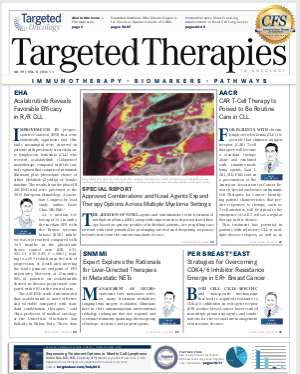Strategies for Overcoming CDK4/6 Inhibition Emerge in ER+ Breast Cancer
Both cell cycle-specific and nonspecific mechanisms that lead to acquired resistance to CDK4/6 inhibition in estrogen receptor-positive breast cancer have resulted in multiple promising agents and combinations for the second-line management of metastatic disease.
Dejan Juric, MD

Dejan Juric, MD
Both cell cycle-specific and nonspecific mechanisms that lead to acquired resistance to CDK4/6 inhibition in estrogen receptor (ER)-positive breast cancer have resulted in multiple promising agents and combinations for the second-line management of metastatic disease.
“CDK4/6 inhibitors in combination with anti-ER agents have clearly played a major role in the frontline setting for ER-positive disease,” said Dejan Juric, MD, to an audience at the18th AnnualInternational Congress on The Future of Breast Cancer® East hosted by Physicians’ Education Resource®, LLC, in New York. “Novel agents will be critical in developing combination strategies and delaying the use of chemotherapy agents in these patients.”
Typically, hormonal and targeted therapy combinations are used to treat patients in this setting, although chemotherapy is still a viable option in some patients, with overall response rates between 15% and 25%.1
The 3 phase III frontline trials that established the role of CDK4/6 inhibitors in ER-positive breast cancer were PALOMA-2 (NCT01740427), MONALEESA-3 (NCT02422615), and MONARCH 3 (NCT02246621) in palbociclib (Ibrance), ribociclib (Kisqali), and abemaciclib (Verzenio), respectively. All trials had impressive hazard ratios (<0.60) for progression-free survival (PFS) compared with the placebo arm, said Juric, of the Termeer Center for Targeted Therapies at Massachusetts General Hospital Cancer Center in Boston. “These results point to the fact that CDK4/6 is important to the ER axis,” he said, explaining that the agents are not identical.
“When you study these targets [and try] to determine what the drug inhibits in terms of various complexes that exist in the cells, we start realizing that abemaciclib blocks the cyclin-ECDK2 complex,” Juric said. The first step in the machinery of the cyclin-D–CDK4/6 axis is driven by CDK4/6, but the second step that is often forgotten is mediated by CDK2. “Often, ER-positive breast cancers compensate for CDK4/6 inhibition...by utilizing CDK2. It is clear that CDK2 will have a key role in the next wave of agents that will be developed in this setting,” he said.
Treatment of Nonmutant Disease
Beyond CDK2, the loss of retinoblastoma (RB) tumor sup- pressor and amplifications of the targets CDK4 and CDK6 are some examples of cell cyclespecific mechanisms of resistance to these agents. For example, loss-of-function mutations inFAT1lead to marked elevations in CDK6 and to poorer outcomes.2Cell cyclenonspecific mechanisms for resistance may include loss of ER and progesterone receptor expression or activation of the FGFR pathway.3In the phase III BOLERO-2 trial, the combination of everolimus (Afinitor), an mTOR inhibitor, plus hormone therapy with exemestane (Aromasin) in patients with recurrent disease following aromatase inhibitors (AIs) had longer PFS with the combination versus placebo plus exemestane (6.9 vs 2.8 months; HR, 0.43; 95% CI, 0.35-0.54;P<.001).4Results of the phase II PrE0102 study suggest that patients with AI-resistant disease also had longer PFS when everolimus versus placebo was added to fulvestrant (Faslodex) (10.3 vs 5.1 months; HR, 0.61; 95% CI, 0.40- 0.92; stratified log-rankP= .02).5
These everolimus combinations are playing “an emerging role in patients with resistance to AI agents,” said Juric. “This regimen provides benefit for patients who do not have additional mutations for treatment.”
PI3K/Akt/mTOR Pathway Alterations
The top target, particularly in the second-line setting, is thePIK3CAmutation that occurs in approximately 40% of patients in this population. The efficacy of alpelisib (Piqray), a PI3Ka-specific inhibitor, was assessed in the phase III SOLAR-1 trial. It showed improved PFS over placebo (11.0 vs 5.7 months) when combined with fulvestrant in patients withPIK3CA-mutated disease (HR, 0.65; 95% CI, 0.50-0.85;P<.001).6
In a subgroup analysis of SOLAR-1 presented at the 2019 American Society of Clinical Oncology Annual Meeting, alpelisib plus fulvestrant showed the most benefit in patients in the second-line setting, defined as those patients whose disease progressed >1 year after endocrine therapy. They experienced a 39% reduction in the risk of disease progression or death compared with patients in the placebo arm (HR, 0.61; 95% CI, 0.42- 0.89).7“Activation of growth-factor pathways that happen sequentially through the progression of the tumor as it becomes less ER-dependent is what drives the PIK3CA activity. As patients progress through first-line therapy, we start to see [more benefit] with alpelisib,” said Juric.
Juric advised that PIK3CA-mutant tumors have a complex genomic landscape and that multiple oncogenic drivers co-occur frequently. It is a rare real-world occurrence to find a patient whose tumor expresses a PIK3CA mutation and no others. “We need to continuously think about the genomic landscape of these tumors, the so-called conditional effect,” he said.
An additional consideration of PI3K inhibition is that it causes rapid upregulation of ER function. Further, Juric said that finding the best possible partner for these agents will help determine the optimal combination for a new generation of agents.
Dual-vertical inhibition, a strategy used in the treatment of melanoma, may be necessary to overcome frequently co-occurring genomic alterations and to bypass path- ways (FIGURE).8Strategies that simultaneously target CDK4/6 and either PIK3, Akt, or mTOR are now being investigated in ER-positive disease and may represent an important step forward in the treatment ofPIK3CA-mutant, ER-positive dis- ease, Juric said.
Cell CycleNonspecific Targets
Alterations inAKTalso drive the PI3K path- way and are commonly seen in ER-positive disease. “This may be the best strategy for [patients with]PTENmutations,” Juric said. The phase II FAKTION trial examined efficacy of the potent and selective Akt1/3 inhibitor capivasertib (AZD5363) plus fulvestrant in patients with ER-positive tumors following progression or relapse with an AI. PFS was extended in the intent-to-treat population from 4.8 months in the placebo arm to 10.3 months in the combi- nation arm, and these results were statistically significant (unadjusted HR, 0.58; 95% CI, 0.39- 0.84;P= .004). The objective response rate (ORR) with capivasertib was 41% versus 12% with placebo.9Estrogen receptor 1 (ESR1) is common in AI-pretreated patients. In the BOLERO-2 trial, patients withESR1mutations had worse outcomes than those who had wild-typeESR1, and those with theESR1Y537S mutation had the worst outcomes overall, according to findings by Chandarlapaty S et al.10Juric suggested that these patients may not derive benefit from the addition of everolimus to exemestane (HR, 0.98; 95% CI, 0.49-1.94;P<.95).
“Now we have to look at the [molecular] profile of our patients and determine the type of mutation, not just that thereisa mutation,” Juric said.
Two classes of drugs are being developed for patients withESR1-mutant disease. The selective ER degrader (SERD) elacestrant (ER1901) has shown promise in patients following AI therapy with an ORR of 23%, despite a large number of patients who were heavily pre- treated.11A phase III study is currently ongoing (NCT03778931).
A drug in phase II of development, the selective ERa covalent agonist (SERCA) H3B-6545, shows mechanistic and phenotypic effects that differ from those of SERDs; their unique conformations may drive novel downstream biology. SERCAs inactivate the estrogen receptor by targeting cysteine, which is not present in other nuclear hormone receptors. This agent is being investigated in women with locally advanced or metastatic ER-positive, HER2-negative breast cancer to determine safety and efficacy (NCT03250676).
References
- Juric D. New agents and markers for endocrine therapy resistance. Presented at:18th AnnualInternational Congress on The Future of Breast Cancer® East host- ed by Physicians’ Education Resource®, LLC; July 19-20, 2019; New York, NY.
- Li Z, Razavi P, Li Q, et al. Loss of the FAT1 tumor suppressor promotes resistance to CDK4/6 inhibitors via the Hippo pathway.Cancer Cell.2018;34(6):893-905.e8. doi: 10.1016/j.ccell.2018.11.006.
- Pandey K, An HJ, Kim SK, et al. Molecular mechanisms of resis- tance to CDK4/6 inhibitors in breast cancer: a review.Int J Cancer.2019;145(5):1179-1188. doi: 10.1002/ijc.32020.
- Baselga J, Campone M, Piccart M, et al. Everolimus in postmenopausal hormone-receptorpositive advanced breast cancer.N Engl J Med.2012;366(6):520-529. doi: 10.1056/NEJMoa1109653.
- Kornblum N, Zhao F, Manola J, et al. Randomized phase II trial of fulvestrant plus everolimus or placebo in postmenopausal women with hormone recep- torpositive, human epidermal growth factor receptor 2–negative metastatic breast cancer resistant to aromatase inhibitor therapy: results of PrE0102.J Clin Oncol.2018;36(16):1556-1563. doi: 10.1200/JCO.2017.76.9331.
- André F, Ciruelos E, Rubovzky G, et al; SOLAR-1 Study Group. Alpelisib forPIK3CA-mutated, hormone receptorpositive advanced breast cancer.N Engl J Med.2019;380(20):1929-1940. doi: 10.1056/NEJMoa1813904.
- Juric D, Loibl S, Andre F, et al. Alpelisib (ALP) with fulvestrant (FUL) in patients (pts) withPIK3CA-mutated hormone receptor-positive (HR+), human epidermal growth factor receptor-2-negative (HER2) advanced breast cancer (ABC): primary or secondary resistance to prior endocrine therapy (ET) in the SOLAR-1 trial. J Clin Oncol.2019;37(suppl 15; abstr 1038). doi: 10.1200/JCO.2019.37.15_suppl.1038.
- Vora SR, Juric D, Kim N, et al. CDK 4/6 inhibitors sensitize PIK3CA mutant breast cancer to PI3K inhibitors. Cancer Cell.2014;26(1):136-149. doi: 10.1016/j.ccr.2014.05.020.
- Jones RH, Carucci M, Casbard AC, et al. Capivasertib (AZD5363) plus fulvestrant versus placebo plus fulvestrant after relapse or progression on an aromatase inhibitor in metastatic ER-positive breast cancer (FAKTION): a randomized, double-blind, placebo-controlled, phase II trial. J Clin Oncol.2019;37(suppl 15; abstr 1005). doi: 10.1200/JCO.2019.37.15_suppl.1005.
- Chandarlapaty S, Chen D, He W. Prevalence of ESR1 mutations in cell-free DNA and outcomes in metastatic breast cancer. a second anal- ysis of the BOLERO-2 clinical trial. JAMA Oncol.2016;2(10):1310-1315. doi: 10.1001/jamaoncol.2016.1279.
- Bardia A, Kabos P, Elledge R, et al. Evaluation of RAD1901, a novel inves- tigational, selective estrogen receptor degrader (SERD), for the treatment of ER-positive (ER+) advanced breast cancer.J Clin Oncol.2017;35(suppl 15; abstr 1014). doi: 10.1200/JCO.2017.35.15_suppl.1014.

Survivorship Care Promotes Evidence-Based Approaches for Quality of Life and Beyond
March 21st 2025Frank J. Penedo, PhD, explains the challenges of survivorship care for patients with cancer and how he implements programs to support patients’ emotional, physical, and practical needs.
Read More